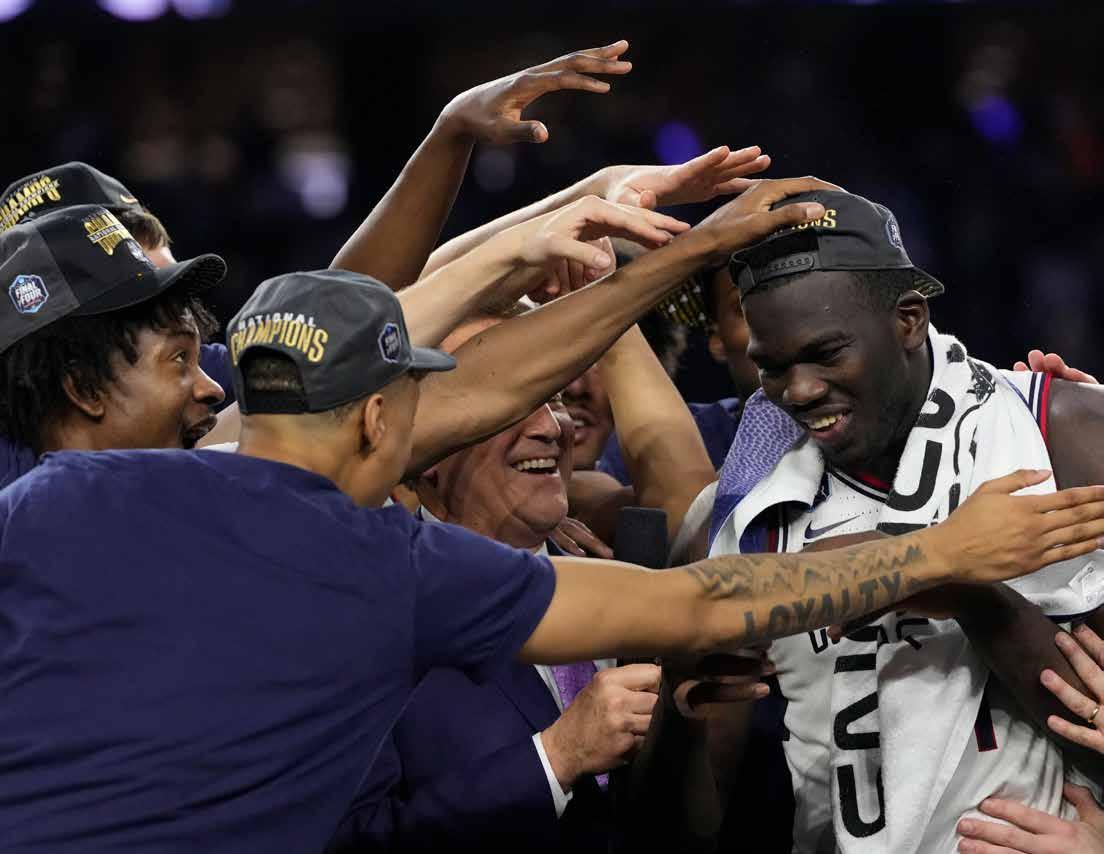
3 minute read
UConn, San Diego State for the NCAA Tournament title started with 2 dreamers
DANA O’NEIL • APRIL 3, 2023
HOUSTON — One used to send his manager out with six minutes left in a game to fetch Jack in the Box — 30 Jumbo Jacks burgers and as many chicken sandwiches, to be exact — so the players would have a postgame meal to eat. The other repeatedly had to explain to residents outside of his tiny state borders that, no, his team was not in the Yukon territory. One school hung its hopes on a beautiful new arena, believing if they built it, they would come; the other played in a place so leaky that, when a recruit came to town, assistant coaches hastily hid the buckets used to catch the water dripping from the ceiling.
San Diego State and Connecticut today seem entirely at odds, disparate in the tinge of their blood and the depth of their success. Until 10 days ago, the Aztecs had never made it out of a Sweet 16, let alone played for a national title. UConn is vying for its fifth championship and making its sixth Final Four appearance.
But in reality, these two programs are more alike than they are dissimilar, each erected on a foundation built by the singular stubborn hopefulness of one man. Steve Fisher eyed a campus steps away from the Pacific Ocean with a tepid basketball history and believed he could make it a winner. Jim Calhoun moved into a state school plopped in the middle of a cow patch, with a basketball program that enjoyed regional success at best, and bulldozed it into a national brand.
On Monday when their pet projects go head to head with a national title on the line, the two coaches will be relegated to elder statesmen spectators. Fisher, who retired in 2017, will be watching from the stands. Calhoun, who intended to be in Houston before a virus fouled up his plans, stepped away in 2012.
Don’t misunderstand, though. This national title game matchup wouldn’t happen without either of them.
The current Connecticut head coach, the one reared across the river from New York and the belly of the Big East in New Jersey, raised in a family where basketball conversation is passed around with the rolls at the dinner table, remembers watching Chris Mullin and Pearl Washington and Patrick Ewing. He does not remember Connecticut. “I didn’t think much about them,” Dan Hurley says. “I’m not even sure I knew they were in the Big East.”
It is yet another opposites attract in this national title game; just like no one seems to remember that San Diego State has been pretty good for a long time (the Aztecs have won three of the last four Mountain West regular-season crowns and have made 10 of the last 13 NCAA Tournaments), everyone’s forgotten that Connecticut was an afterthought once. Understandably it’s a hard memory to flame, the sepia tone of the early-year struggles glazed over by the blinding glitter of success. But in 1979, when Dave Gavitt was piecemealing together his soon-to-be colossus Big East, “Nobody wanted UConn,” former Big East commissioner Mike Tranghese says. The school didn’t fit the private, Catholic profile but more, it didn’t resonate. Successful in the small-time Yankee Conference, the Huskies lacked the panache of everyone else invited to the conference and had Father John Brooks, the president of Holy Cross, accepted Gavitt’s invitation, who knows if UConn would have made the final cut.
Recognizing the reluctance, Gavitt gave UConn athletic director John Toner three days to decide if they were in or out; Toner said yes immediately, without even consulting his administration, figuring it was best to ask forgiveness later than permission up front and risk delaying the decision. “If we hadn’t joined the league, we’d be Vermont,” Calhoun says now. “A good program, steady, successful but not at all what we are now.”
The league, however, did not immediately imbue the Huskies with relevance. Instead it ate them alive. By 1985, while St. John’s, Georgetown and Villanova were going to the Final Four, UConn was 6-10 in the conference and the subject of a 20-person university task force investigation that questioned the athletic department’s attachment to the rest of the school. “The Northwestern of the Big East,” people snickered in print about the Huskies, convinced the ill-fitting school would never be more than a drag on the league’s reputation. Coach Dom Perno resigned, and the school sought a coach that could match the rigors of the new conference.
They found Calhoun, a fast-talking Southie from Boston who stoked his reputation on rebuilding, first at Dedham High School and later at Northeastern. But not quite the same as rowing against the likes of John Thompson Jr., Jim Boeheim and Lou Carnesecca. “We were not ready basketball wise,” Calhoun says. “At that time, Manhattan had a better program, But we had some history, and people loved basketball. It was just very parochial.” So much so that, when Calhoun tried to recruit outside of the state or tell people about it, they’d hear ‘UConn Huskies,’ and think “Yukon Huskies.” “People thought we were in Alaska,” Calhoun says.






